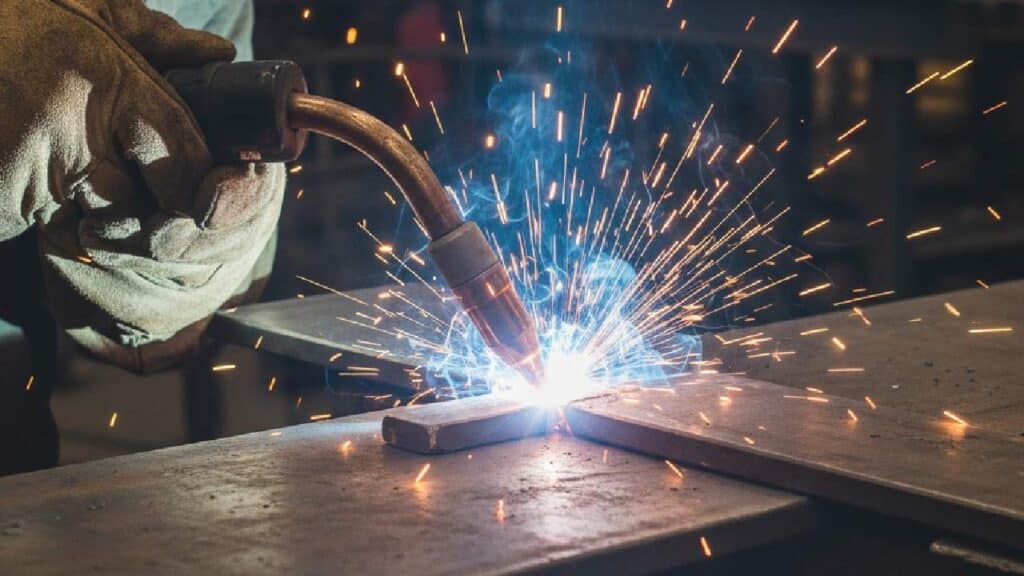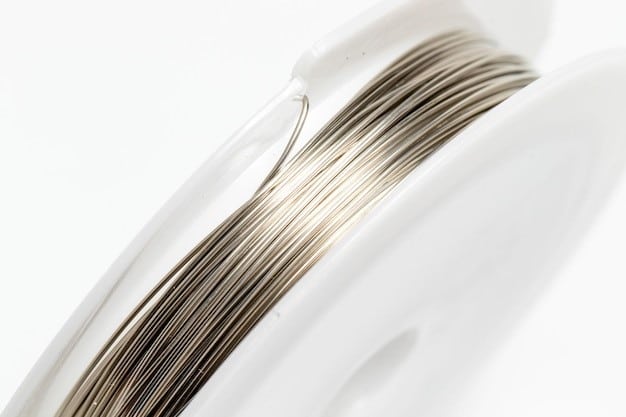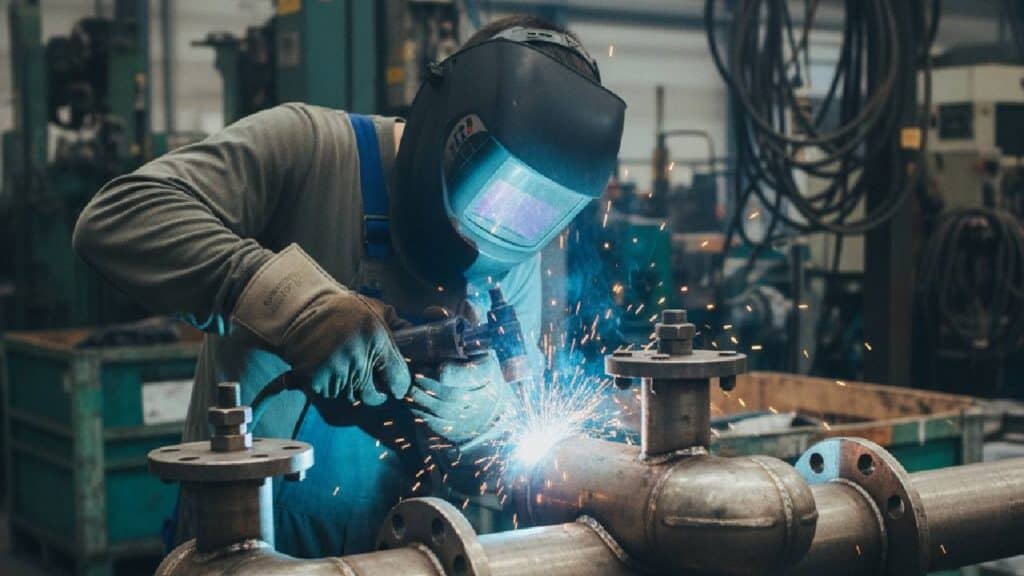Welding undoubtedly plays an important role in manufacturing, repair, and the creation of bonds between metal elements.
Today’s guide highlights every element of Short Circuit Welding. How it works and what equipment is used in the operations. What are the advantages of this type of welding, and where is it applicable? Let’s start the discussion.

Understanding Short Circuit Welding
Short circuit welding is also known as short-arc welding or short-circuit transfer. It is actually a metal transfer mode in Gas Metal Arc Welding (GMAW) where the welding wire continuously makes contact with the weld pool, forming a short circuit. As a result of this short circuit, the welding wire melts and delivers molten metal into the joining area or the material to create a strong bond.
According to experts, this process occurs around 80 to 200 times per second. Throughout the procedure, short-circuit welding uses the minimum voltage and current, reducing the risk of material burning.
In terms of compatibility, short-circuit welding meets the requirements of the automotive, fabrication, and construction industries. Similarly, this type of welding is cost-effective, efficient, clean, and user-friendly.
Core Features
- It operates at low voltage and current, resulting in an energy-efficient process.
- It produces an appropriate amount of heat, eliminating the risk of material burning.
- The short-circuit procedure repeats the cycle 80 to 200 times per second.
- It suits the thinner, out-of-position areas for welding.
- It is budget-friendly, user-friendly, and suitable for beginners to learn welding.

How Short Circuit Welding Works?
The short-circuit welding process consists of the following steps.
1: Short-Circuit Formation
This is the first step in the working procedure for short-circuit welding. Here, the welding wire repeatedly makes contact with the base material. This forms a short circuit, where the current flow increases and the voltage drops to zero. Overall, the short-circuit formation lasts about 10ms.
2: Heating and Melting
After a short circuit forms, the wire melts, and a molten droplet forms at the tip. The heat generated by electrical resistance is within acceptable limits to avoid burning or other damage to the thin material. While it is well enough to make a connection between the base metal and the filler.
3: Metal Transfer
Here, in the metal transfer step, the droplet material from the tip is transferred to the weld pool to fill the gap or form the joint. During the transfer, the arc level is maintained, ensuring accurate deposition by preventing spattering. It can be applied to most positions, such as flat, vertical, and others.
4: Arc Reignition
Well, as the name suggests, arc reignition: once the droplet detaches from the tip, the welding wire and weld pool continue to form another short circuit. As we discussed earlier, this cycle repeats about 80-200 times per second. Each time the molten metal detaches from the tip to make a joint with the material.

Equipment and Setup for Short Circuit Welding
1: Welding Power Source
To power up welding operations, a power source is required. For short-circuit welding, a constant-voltage (CV) power source is used to control the process. Its main function is to reduce the voltage and increase the current when the wire contacts the base material. It helps to maintain a smooth control over short-circuit formation.
2: Wire Feeder
The wire feeder, as equipment here, controls the wire feed speed to maintain a stable arc. If the speed is above the recommended range, it may cause over-short-circuiting. Similarly, if the speed is below the recommended range, the arc may be disturbed. Modern wire feeders are available, offering a digital speed control system.
3: Welding Torch or Gun
The welding torch or gun is equipment that directs the electrode wire, shielding gas, and electrical current to the welding point. A welding torch usually features a contact tip, a gas diffuser, and a nozzle to transfer the current and distribute shielding gas. A quality welding gun keeps the operations smooth, stable, and efficient.
4: Shielding Gas
Short-circuit welding is highly prone to oxygen, nitrogen, and hydrogen. They can significantly affect penetration level, spattering, and the arc system. To control these impacts, shielding gas is used to maintain balanced parameters. It includes CO2, Argon, and CO2 mixtures at ratios of 75-25% or 80-20%.
5: Filler Wire
Here, the filler wire is used as both the conductor and the filler metal between the welding joints. The known types of wires include mild steel wires (ER70S-3, ER70S-6) for steel applications, stainless steel wires (ER308L, ER309L) for corrosion-resistant applications, and aluminum wires (ER4043, ER5356) for light applications.

Short Circuit Welding Parameters
The following parameters must be considered to achieve high-quality short-circuit welding.
- Voltage: It usually controls the length of the arc and should be around 16-22 V. Higher or lower values may cause malfunctions.
- Amperes: These are adjusted to control the heat input/penetration process and should be around 50-200 A. The range also depends on wire diameter and material thickness.
- Wire Feed Speed: It controls the deposition rate and should be around 100-400 in/min. Increasing the wire feed speed will affect the current and heat.
- Shielding Gas Flow: It provides protection against oxidation and should be around 20-30 CFH. A mixture of 75% Argon + 25% CO2 is considered stable for arc.
- Stickout Length: The recommended stickout length is 3/8 to 1/2 inches. The longer length reduces current and heat, while the shorter length increases penetration.
Applications of Short Circuit Welding
1: Automotive Industry
Welding experts in the automotive industry consider short-circuit welding an ideal welding method. Because it supports welding thinner materials and features a low heat input, it produces neat, clean welds. Short-circuit welding meets the requirements for welding thinner car parts, frames, chassis, and exhaust with minimal to no risk of burning.
2: Pipelines and Plumbing
The short circuit welding process also has a positive reputation in the pipeline and plumbing industry. It features a safe, secure, and efficient control for root passes and out-of-position welds in pipeline installations. When it’s a matter of pipes carrying gas or fluid, there should be no leakage guaranteed. Short-circuit welding ensures that this requirement is met.

3: Fabrication and Manufacturing
In the fabrication and manufacturing departments, short-circuit welding is preferred due to its unique attributes. It is used at low to medium levels for welding thin materials such as steel, stainless steel, and aluminum sheets. Similarly, it is used to manufacture items such as cabinets, furniture, and other products with unique and complex designs.
4: Construction Industry
Well, in the construction department, short-circuit welding has become a must-have piece of equipment. It is used to create a joint between multiple construction-related phases and items, such as steel frames, beams, roofing, and building piping. Most construction-related activities require appropriate heat intervention, and short-circuit welding does it well.
5: Home and DIY Projects
Short-circuit welding is also a choice for DIY enthusiasts or those who want to perform small welding tasks at home. The credit goes to the cost-effectiveness and user-friendly control of this welding mode. At the home level or for DIY projects, short-circuit welding can be used to join metal gates, windows, grills, and other metal-made decorative items.
Advantages & Disadvantages
Advantages
- Short Circuit welding works well for thinner materials, such as those less than 3 mm thick.
- This type of welding is compatible with multiple positions, such as flat, vertical, horizontal, and overhead.
- Short Circuit welding results in neat, clean, and efficient welding due to the use of argon-rich gas mixtures.
- This type of welding is considered a cost-effective and user-friendly option for most.
- Short Circuit welding is an appropriate choice for welding out-of-position areas.
Disadvantages
- Because it features limited penetration, it is not suitable for welding thicker materials.
- If parameters like voltage and wire feed speed are not adjusted accordingly, it may result in spatter.
- The deposition rate in short-circuit welding is lower than in other MIG modes.
- Inaccurate parameter adjustments can result in a cold lap or incomplete fusion.
- Short Circuit welding requires a cleaner workspace free of dust, oil, and other contaminants.
Working Tips for Quality Welds
- Make sure the arc length is short and consistent to allow for smooth control.
- Make sure to set the wire feed speed and voltage to the recommended settings for the material thickness.
- Make sure to set the welding gun angle at 10 to 15 degrees for the required metal transfer.
- Make sure the working area remains neat and clean to avoid contamination.
- Maintain a steady travel speed to minimize the risk of poor fusion.
- Make sure to use a 75% Argon + 25% CO2 mixture to avoid oxidation.
Precautionary Measurements
- Don’t forget to wear a welding helmet, gloves, safety boots, and a fire-resistant uniform.
- Ensure you work in a fully ventilated area, as some gases may affect breathing.
- Don’t place any flammable materials in your work area, as they may catch fire.
- Thoroughly inspect the cables, connectors, and the welding gun before starting to work.
- Keep the working area clean and dry to avoid any possible misap.
Conclusion
A short-circuit MIG welder is undoubtedly one of the most efficient, easy-to-use, and cost-effective modes of MIG welding. Especially when the material is thinner or out of position to weld. As a choice for the automotive, piping, and construction industries, short-circuit welding has proven itself to be the most reliable, clean, and durable welding method. Moreover, it meets the needs of smaller workshops and DIY enthusiasts thanks to its ease of use and budget-friendly pricing. Just have a deep understanding of its recommended parameters and adjustments before the welding attempt.
As a welding enthusiast and professional, if you are searching for a reputable and reliable supplier, look no further. Yeswelder has brought together MIG Welder, TIG Welder, and Stick Welder on a single platform. Contact us for more information and queries.
Frequently Asked Questions (FAQ)
It’s called a “short circuit” because during the process, the welding wire actually touches the weld pool, creating a momentary electrical short. This short causes the wire tip to heat up and melt, allowing molten metal to transfer into the joint. The circuit then reopens and repeats many times per second.
Not exactly. RMD (Regulated Metal Deposition) is a modified short-circuit process that precisely controls current during each short, resulting in smoother metal transfer and less spatter. Spray transfer, on the other hand, uses higher voltage and current to create a continuous stream of metal droplets. RMD runs cooler and is better for root passes or thin materials, while spray transfer is ideal for thicker materials and higher deposition rates.
The short-circuit current is the peak current that flows when the electrode wire touches the weld pool and creates a short. It typically ranges from 50 to 200 amperes, depending on the wire size, material thickness, and machine settings. This high current is what melts the wire tip before it transfers into the weld pool.
Avoid using short-circuit transfer on thicker materials that need deep penetration. It’s also not recommended for dirty or rusty surfaces since contaminants can cause spatter and poor fusion. Finally, improper settings — such as too low voltage or too high wire feed speed — can lead to cold laps and weak welds.



